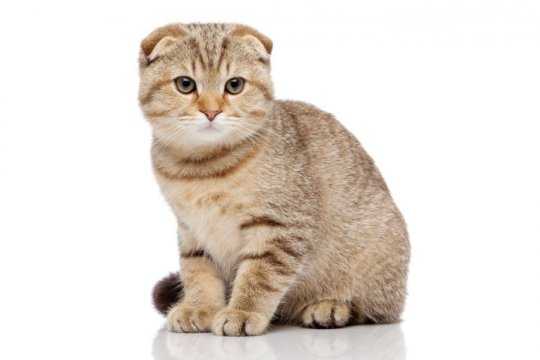Scottish Fold

Origin
United Kingdom
Height
8"- 10"
Adult Weight
6-13 pounds
Life Span
13-15 years
TEMPERAMENT
Family-oriented, quiet, affectionate, loyal
OTHER NAMES
Highland Fold, Scot Fold cat
Group
Medium to large short-haired and long-haired
Price
$1000 - $2000
Personality and Temperament
Care
- NUTRITION
- GROOMING
- EXERCISE
- HEALTH
Characteristics
History
The Breed Standard
Body
The body has a rounded appearance, and is well-padded. Males may be significantly larger than females.
Head
The head is well rounded, with round whisker pads and prominent cheeks. The chin and jaw are firm. Males may exhibit significant jowliness.
Eyes
The eyes are large and well rounded, separated by the nose, which is broad. The eyes have a sweet expression and a wide, open appearance. Eye color corresponds with coat color.
Ears
The Scottish Fold cat’s ears are small, folded forward and downward, and set to expose the head’s rounded cranial structure.
Legs & Paws
The legs are strong and proportionate to the body. The feet are well rounded.
Tail
The Scottish Fold cat has a medium to long tail that is in proportion to the body. The tail tapers, and has a rounded tip rather than a whippy appearance.
Coat
The coat may be long or short. Short-hair Scottish Fold cats have a dense, plush coat with a soft texture, with hair that stands away from the body. Medium-long to long-hair Scottish Fold cats have a full coat with toe tufts, a ruff, britches, ear furnishings, and a pronounced tail plume. In long-haired cats, short facial hair is permissible. Long-haired Scottish Folds are sometimes called Highland Fold cats.
Color
The Scottish Fold may be any color or pattern. Buttons and lockets are permitted. Nose leather and paw pad color correspond with coat color.
Frequently Asked Questions
-
How much does a Scottish Fold cat cost?
How much does a Scottish Fold cat cost?Pet-quality Scottish Fold kittens range depending on whether they have folded or straight ears; kittens with folded ears are more expensive. In general, a Scottish Fold usually cost between $1,000 and $2,000. -
How big do Scottish Fold cats get?
How big do Scottish Fold cats get?Scottish Fold cats are medium sized. Males tend to be larger than females. On average, a fully grown male Scottish Fold cat might weigh between 9 and 13 pounds, with females averaging 6 to 9 pounds. The breed is about 8 to 10 inches tall. -
How long do Scottish Fold cats live?
How long do Scottish Fold cats live?The average life span for Scottish Fold cats is about 15 years. -
Do Scottish Fold cats shed?
Do Scottish Fold cats shed?Scottish Fold cats come in short and long hair. Both short-haired and long-haired Scottish Fold cats shed, with some individual cats shedding more than others. Daily brushing can cut down on shedding by removing loose hair from the coat.